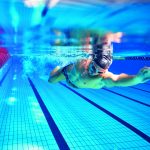The beginners’ guide to Aquafitness
Everybody at the very beginning of their life floats instinctively in the water.
In some ways, that’s the concept underlying aquafitness, which is a sparkling way of relating to water.
With this post we will start a journey in the wonderful world of aquatic programs, exploring the origins, the benefits and the wide range of courses offered in pools, gyms and holiday villages across the world.
Aquafitness represents undoubtedly one of the most interesting lifestyle trends, which after 30 years (first spread in the US), has seen a consistent growth.
Its uniqueness lies in being absolutely perfect for everybody, and can be performed as a stand-alone activity or to complement swimming or any other fitness activity.
“All ages and abilities can practice aquafitness”, affirms Sue Nelson, Aquatic Programming Specialist at USA Swimming, “everybody who is targeting cardiovascular endurance, muscular strength, core stability and range of motion. It all depends on which area of fitness one wants to address their efforts”.
With true passion and firm belief in her commitment to promote aquatic programs in the US, Sue enthusiastically adds “while swimming, our intent is to streamline each movement horizontally, propelling our body forward with the smallest amount of effort.
Aquafitness is a vertical exercise, which leverages the properties of water to create an efficient workout, generating a definite challenge naturally increased by surface area and resistance of water”.
The benefits most commonly credited to Aquafitness are: burn calories, tone up and have fun with music. But there is something more about it: in fact, it is warmly recommended to everybody, also in cases of injury, chronic conditions and in pregnancy too.
Floating in the water helps reduce weight stressing on the joints and the impact of the movements are definitely milder. This is the end of the “No pain, no gain” theory as we know it.
There is only a general guideline to follow, as suggested by Aquatic Exercise Association: “move comfortably, monitor intensity, and stop or adapt any exercise that causes discomfort”.
Aquagym is the forerunner of all disciplines based on the concept of water exercise, but nowadays aquatic class formats include over 70 different courses, many of which are land-based formats adapted to the pool environment. Aqua Zumba®, interval training, circuits, kickboxing, aqua spinning, aqua dance, yoga, power water, water combat are only some example of the most followed and renown ones.
Stay tuned and discover with us what aquafitness can do for our inner and outer wellness.
Written by:
Antonella Lupica
Antonella is a freelance writer who has an amazing relationship with water and sports in general. She likes swimming with her two little children, and has done since they were 3 months old (now they are 3 and 6 years old), teaching them to embrace and not fear the water. She also enjoys swimming alone, where she experiences true wellness and relaxation. She is curious and loves investigating new trends in sport and lifestyle.








